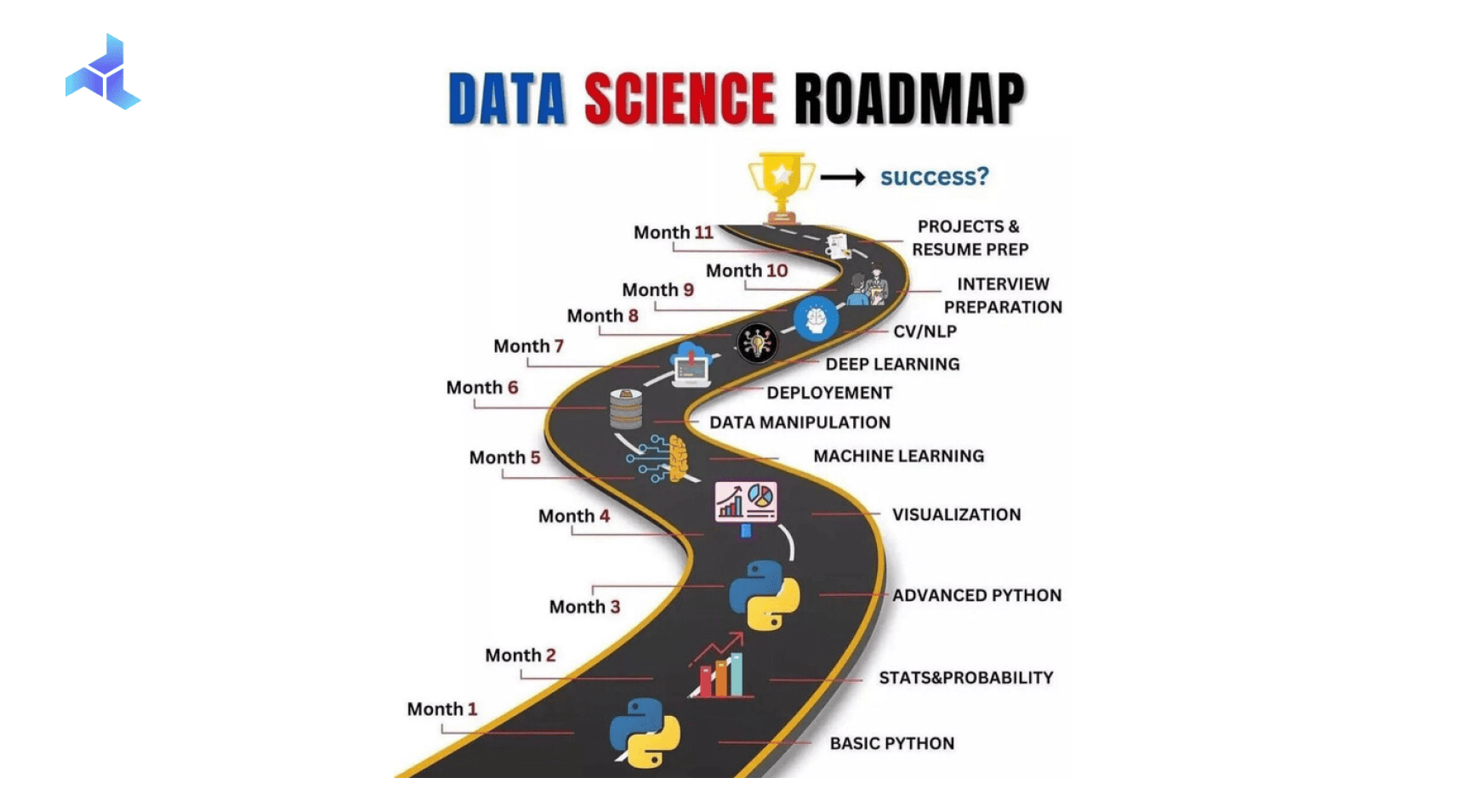Introduction
Embarking on your journey of becoming a successful Data Scientist without a clear roadmap can indeed be pretty frustrating. We would therefore like to present you with a holistic roadmap, one that would get you through the steps involved in the field of data science, from basic Python programming to advanced machine learning and then finally to interview preparation. This roadmap shall be your way forward in succeeding in the data science industry.
Month 1: Basic Python
By the completion of this course, you ought to have a decent working knowledge of Python, as it’s the most vital language for doing Data Science. Probably one of the most important things you will do in your first month is going to learn all about Python programming details, including variables, data types, loops, functions, and basic data structures. You can become familiar with NumPy & pandas. These are the libraries in Python under which data manipulation & analysis are broadly put.
Month 2: Statistics & Probability
One will need to know statistics and probability for data analysis and building of models. Go deep into statistical concepts, such as probability distributions, hypothesis testing, confidence intervals, and regression analysis. Apply this in practice by using statistical methods on real-world data sets with Python libraries scipy and statsmodels.
Month 3: Advanced Python
Study advanced topics that are usually not covered at entry-level in Python: object-oriented programming, functional programming, decorators, metaprogramming. Do parallel computing with libraries like multiprocessing and concurrent.futures in order to achieve parallel computation for faster data processing. Advanced Python concepts will help in writing efficient, maintainable, and scalable code.
Month 4: Visualization
Data Visualization is an easy way to extract insights, and communication of findings will be very effective. Learn how to systematically create business-impacting, persuasive visualizations using libraries such as Matplotlib and Seaborn. Learn about data visualization principles: proper chart types, appropriate coloring schemes, proper labeling. Practice in creating meaningful visualization to enhance data storytelling.
Month 5: Machine Learning
Now that you have a good background in Python and statistics, it’s time to explore machine learning. Learn about important traditional machine learning algorithms that include linear regression, logistic regression, decision trees, random forests, and support vector machines. Learn how to put the algorithms into practice by implementing them in popular libraries like scikit-learn.
Month 6: Data Manipulation
Data manipulation is one of the most important steps in any workflow involving data science. Learn sophisticated data manipulation tactics and techniques with Python libraries, including pandas and SQL.Discuss various ways of cleaning, preprocessing, merging, reshaping, and handling missing values within datasets. Manipulate large datasets efficiently to extract relevant information for analysis.
Month 7: Deployment
Understanding how to deploy your data science models to production is crucial for real-world applications. Learn techniques for model deployment with Flask and Django. See cloud services like AWS and Azure for scalable and reliable deployments, and know containerization technologies like Docker for reproducible environments.
Month 8: Deep Learning
It is time to explore the deep learning innovative area, which enables advanced computer vision and natural language processing applications. In this course you will study neural networks, Convolutional Neural Networks, Recurrent Neural Networks and deep learning frameworks like TensorFlow and PyTorch. Put into practice deep learning models for image classification, text generation, and sentiment analysis.
Month 9: Computer Vision/Natural Language Processing (CV/NLP)
Deal with the areas of specialization in the domains of computer vision and natural language processing. Learn image processing techniques, object detection, and image segmentation. Study tasks in natural language processing involving text classification, sentiment analysis, named entity recognition, and machine translation. Apply pre-trained models and learn to build your own models for CV/NLP tasks.
Month 10: Interview Preparation
Practice for your data science interviews. Review key concepts, algorithms, and techniques. Solve practice interview questions and engage in coding challenges through LeetCode and Kaggle. Improve your communication skills by making sure to muscle up on data science storytelling and being able to describe complex things in a simple, succinct way.
Month 11: Projects & Resume Preparation
Apply your knowledge by working through a variety of real-world projects in data science that interest you and solve different problems. Build a diverse portfolio that showcases different skill sets in data cleaning, visualization, modeling, and deployment. Create a sophisticated resume highlighting your projects, skills, and achievements. Be confident in your ability to effectively present projects during an interview.
Success:
Well, congratulations! You now have a truly deep understanding of data science, as you have fully followed this overall roadmap. You’ve learned programming in Python, statistics and advanced techniques, visualization, machine learning, manipulation of data, deployment, deep learning, and CV-NLP. You enhanced your interview skills and gained project experience. Give it time, practice, and learning—these will help you succeed through all the dynamism of the field called data science.
Remember, this isn’t the end. Keep improving yourself by getting involved with the newest developments in the field and constantly striving to improve upon your skills in the best possible manner. Data science is a community rich in growth and innovation opportunities. All the best on your pathway to success!
Share this content:






Post Comment